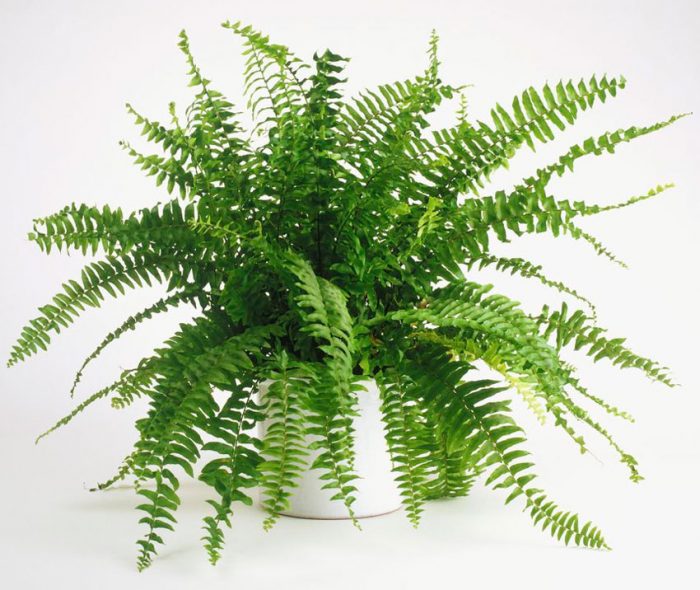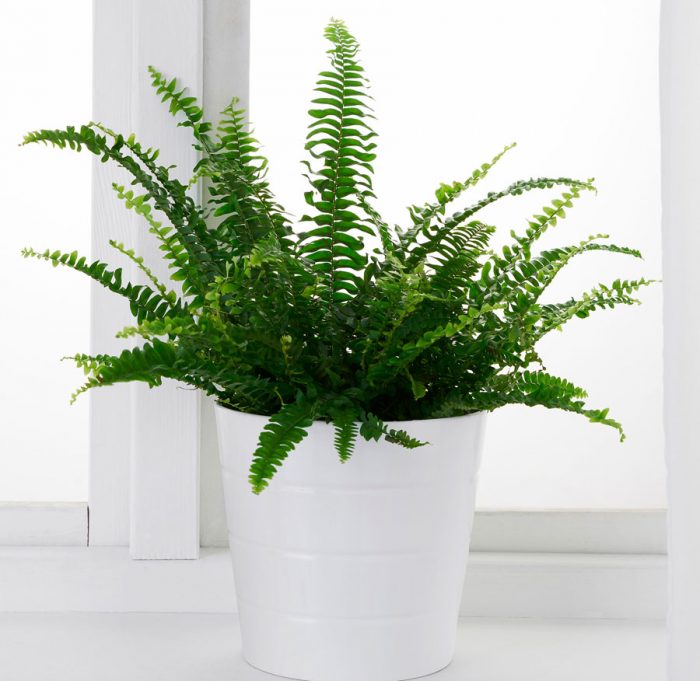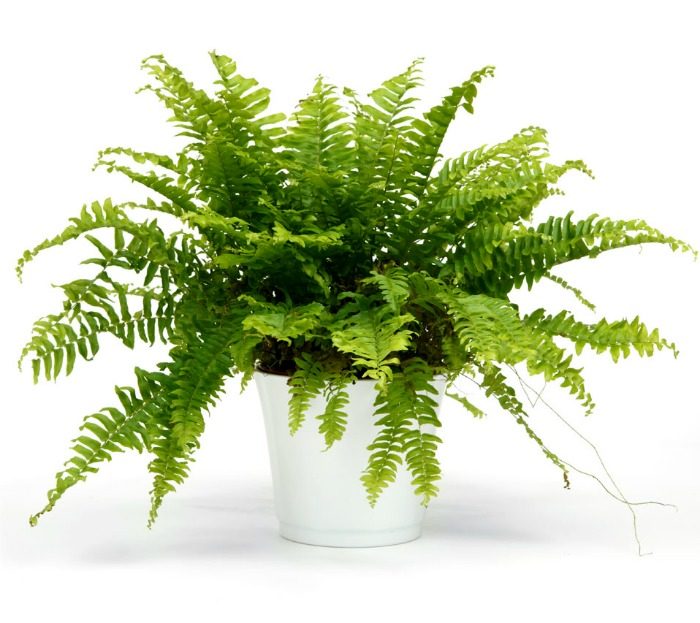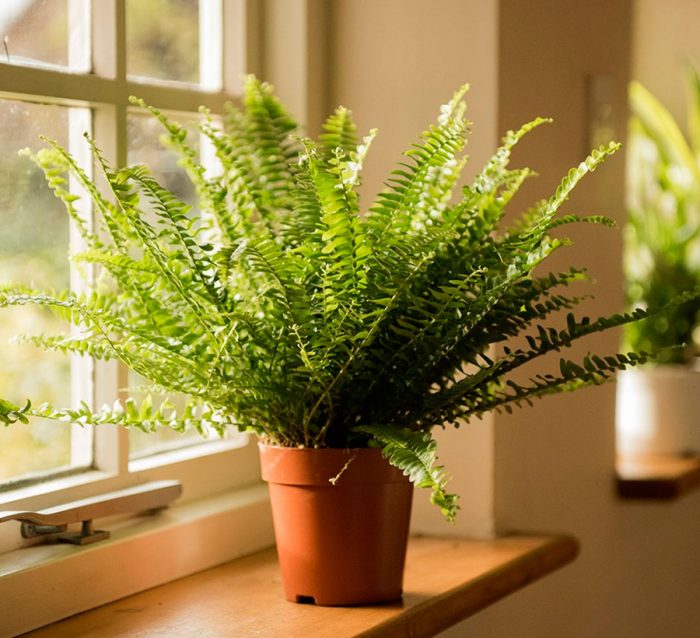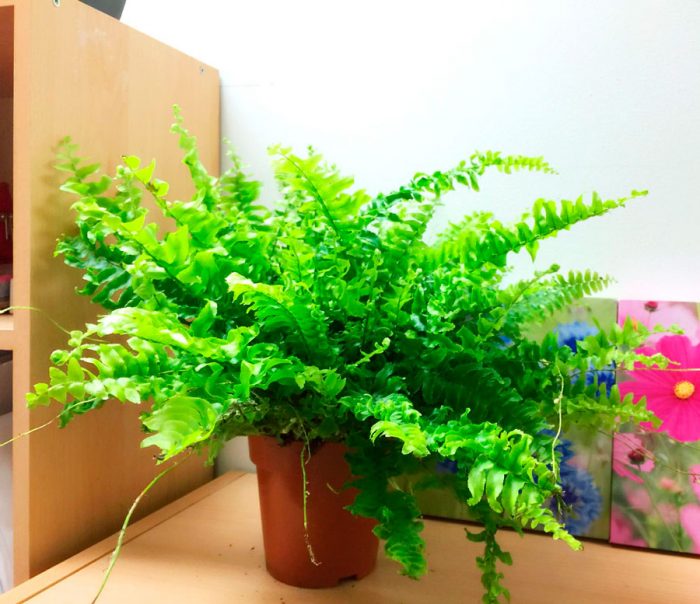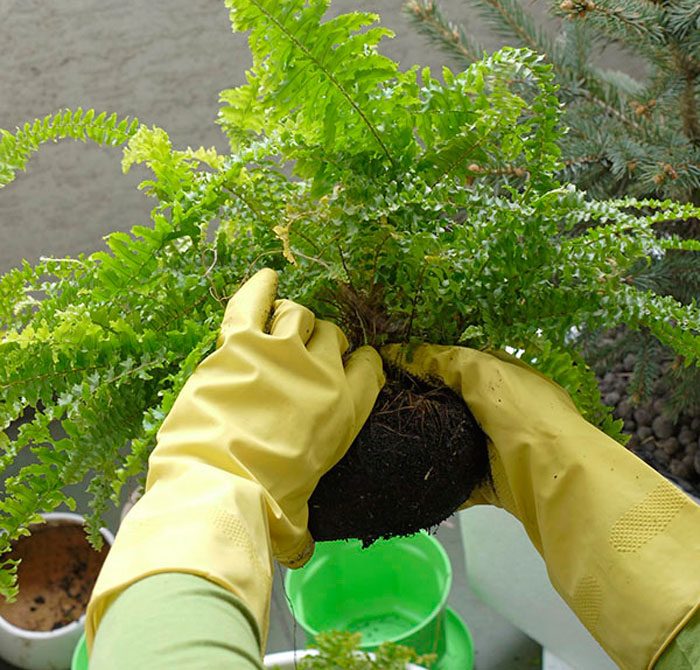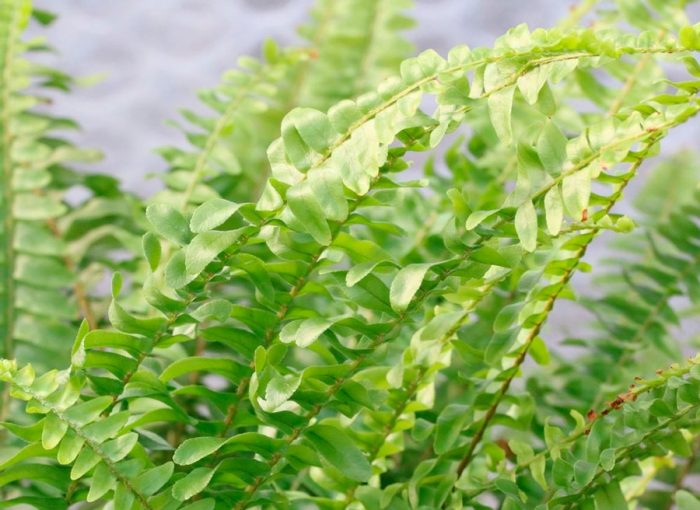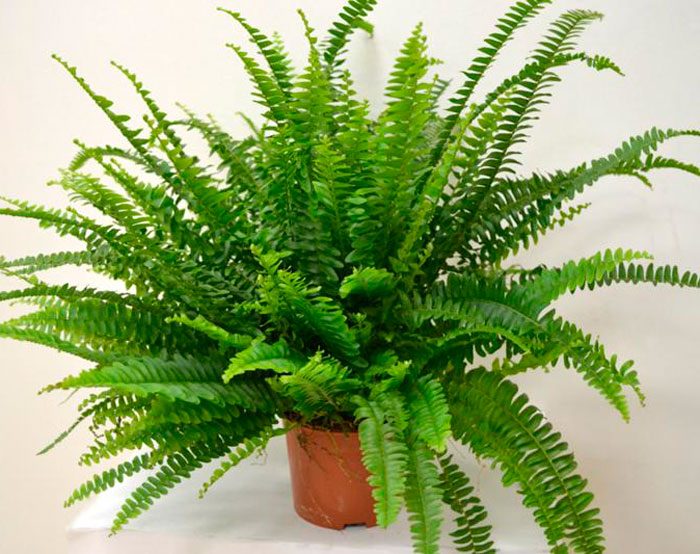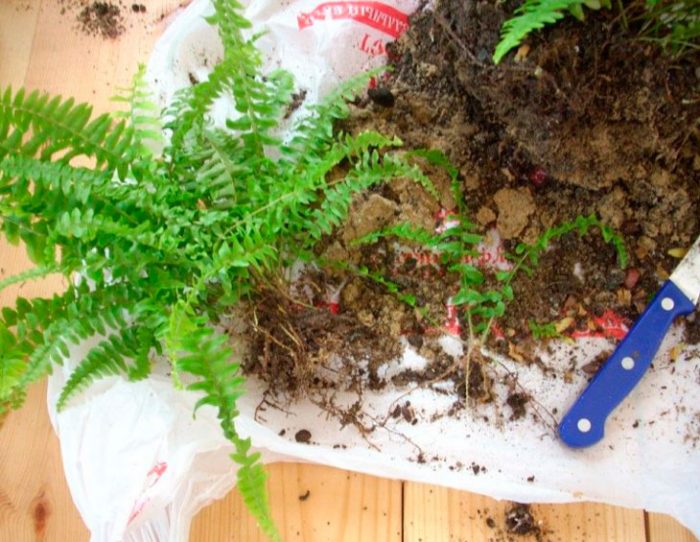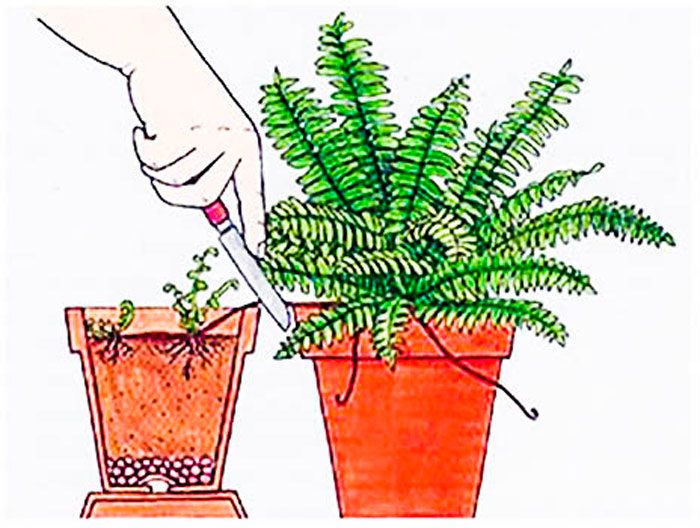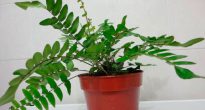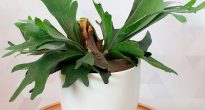The plant nephrolepsis (Nephrolepis) is a species of the genus of ferns of the Lomariopsis family. In some classifications, this plant belongs to the Davalliev family. The Latin name was formed from two Greek words "nephros" and "lepis", which translate as "buds" and "scales", this is due to the shape of the veil. In the wild, there are about 30 species of such a plant, while it is distributed throughout the world. Nephrolepsis comes from the shady forests of tropical America, Southeast Asia, Africa and Australia. The fern is grown as an ampelous or pot plant and is used as a decor for various interiors. In addition to the fact that such a plant has a spectacular appearance, it also perfectly cleans the air.
Content
Brief description of cultivation
- Bloom... Such a fern does not form flowers.
- Illumination... Sunlight must necessarily be diffused. The pot is placed near the window of a western, northern or eastern orientation. The duration of daylight hours required for such a plant is from 14 to 16 hours.
- Temperature regime... During the growing season - from 20 to 24 degrees, during the dormant period - about 15 degrees.
- Watering... The frequency and abundance of watering is influenced by the air temperature in the room. So, the cooler the room, the less water the plant needs. Remember that between waterings, the surface of the soil mixture in the pot must dry out.
- Air humidity... It should be elevated. To do this, the bush is regularly and quite often moistened with a spray bottle, they systematically arrange a shower and place the pot on a tray filled with wet pebbles.
- Fertilizer... Top dressing is carried out in March – September with a frequency of 3 or 4 times a month. For this, a complex fertilizer is used for decorative deciduous plants. If the bushes are warm in winter, then they will need to be fed once every 30 days.
- Dormant period... In October – February.
- Transfer... Young bushes are transplanted every year, and older specimens are transplanted once every 2 or 3 years.
- Reproduction... Such a fern can only be propagated by vegetative methods, namely by shoots, offspring and dividing the bush.
- Harmful insects... Aphids, whiteflies, spider mites, root worms and scale insects.
- Diseases... The plant can lose its spectacular appearance due to excessively low humidity or improper care.
Features of the fern nephrolepsis
The herbaceous plant nephrolepsis can be terrestrial or epiphytic. Its rhizome is relatively short. The rosette includes greenish pinnate leaf plates with short petioles, their length is about 0.7 m.The plates include serrate-crenate segments of the lanceolate shape, their length is about 50 mm, on their seamy surface on both sides of the median vein are located rounded sori. Over time, the leaf plates turn yellow and die off. Leafless shoots extend from the rhizome, the surface of which is covered with scales. Such shoots give roots quickly enough when rooting.
Home care for nephrolepis
Before purchasing nephrolepsis, which will be grown indoors, it is imperative to know how to care for it.
Illumination
Sunlight must always be diffused, as direct scorching rays can harm the fern. In this regard, it is recommended for him to choose a place away from the window opening and from the direct rays of the sun. If you decide to give him a place on the windowsill, then preference should be given to those windows that are located in the western, northern or eastern part of the room.
For normal development and growth, the duration of daylight hours required for nephrolepsis is from 14 to 16 hours in this regard, if you want your bush to be very lush and spectacular, then it will have to be supplemented. This fern develops within the normal range under fluorescent lamps; therefore, it is often adorned with the halls of large office centers or hotels.
Temperature regime
In the spring-summer period, the best air temperature for this plant will be from 20 to 24 degrees. However, if you moisten its foliage often enough with a spray bottle, then you can grow it at higher temperatures. During wintering, it needs coolness (about 15 degrees) and remember that the bush should be located as far as possible from heating appliances. If you cannot transfer nephrolepsis to a cool place for the winter, then let it grow where it grew, while moisturizing the foliage and watering it in the same way as in the warm season. During warm wintering, its growth and development will not stop, but they will slow down significantly.
Top dressing
Fern grown in indoor conditions must be systematically fed, for this, complex fertilizers are used for decorative leafy plants, while the concentration of the nutrient solution should be ¼ of that indicated on the package. Fertilizers are applied in March – September 3 or 4 times every 30 days. If the bush is in a cool place in winter, then there is no need to feed it at this time. However, if the bush hibernates in the warmth, then they continue to feed it, but this is done at intervals of no more than 1 time in 4 weeks.
How to water
Water the bush immediately after the top layer of the substrate in the container dries out. At the same time, the air temperature in the room has a direct effect on the frequency and abundance of watering, so the cooler the room, the less liquid the plant will need. During cool wintering, watering should be infrequent and more scarce than usual.
Air humidity
The humidity in the room where the fern is located should be increased. To achieve this, it is necessary to systematically and quite often moisturize the foliage from the sprayer, and also try to arrange a shower flower at least once every 30 days.To increase the humidity, it is recommended to pour expanded clay or pebbles into the pallet and pour in enough water so that it does not come into contact with the bottom of the pot. For irrigation, use filtered or well-settled water at room temperature.
Nephrolepis transplant
While the plant is young, its transplant is carried out annually in the spring, older specimens are transplanted no more than 1 time in 2 or 3 years. For growing such a culture, it is recommended to choose a plastic container, because moisture in it will retain moisture in the substrate much longer compared to ceramic pots. The bush has a superficial root system, therefore, for planting it, it is worth choosing a low but wide capacity.
During the transplantation of the bush, for a start, a good drainage layer is made of expanded clay at the bottom of the container, after which it is covered with a layer of light soil mixture, its approximate composition: coniferous and greenhouse soil and high peat (1: 1: 1). Experts advise adding bone meal to the ready-made substrate (5 grams per 1 kg of soil mixture). If you do not have a desire to prepare the substrate yourself, then purchase a ready-made one in a specialized store, an acidic soil mixture for ferns is suitable for this, as well as soil for calla lilies, camellias or hydrangeas with a pH of 4.5–5.5.
During transplanting, make sure that the root collar of the bush rises above the surface of the substrate. The first time after transplanting, the bush must be provided with a constant high air humidity, and also make sure that the soil mixture in the pot is slightly damp all the time.
Pests and diseases of nephrolepis
If, when grown in indoor conditions, the fern is improperly taken care of, then there is a high probability that aphids, spider mites, whiteflies or scale insects will settle on it. To get rid of such harmful insects, the plant must be sprayed with a solution of an insecticidal preparation, for example: Aktara, Aktellik, etc.
Possible problems
- Drying foliage... The most common reason that leaf plates dry out is very rare or poor watering. In the case when only the tips of the leaves dry up, the excessively low air humidity is to blame.
- Flying around foliage... In some cases, the leaves can change their color to brown, after which they fold and fly around. This can happen for several reasons: the room is too cold, the bush is watered with too cool, hard or chlorinated water, or has been exposed to a draft.
- Dry specks on foliage... Most often, dry spots on the surface of leaf plates appear as a result of sunburn.
Nephrolepis properties
Some experts are sure that such a fern is capable of absorbing electromagnetic radiation and energy harmful to the human body. And it also helps to strengthen the body's defenses and tones it up, and can also cleanse the air from harmful fumes and dust. At home, nephrolepsis can be placed near the TV or not far from the computer, and it will also be a wonderful decoration for any office. According to psychologists, if such a plant stays close to a person for a sufficiently long time, this will contribute to the identification of perseverance, prudence and perseverance. But it should be borne in mind that the smoke from tobacco helps to reduce such beneficial properties of the fern.
Reproduction of nephrolepis
Nephrolepsis can only be propagated vegetatively, namely, by shoots, division of rhizomes, or by offspring. This is because most of the fern varieties are sterile. Ay of those varieties in which spores are formed, they do not retain the varietal characteristics of the parent plant.
Dividing the bush
As a rule, the division of the bush is carried out in the spring and they try to combine this procedure with a transplant. For division, large adult bushes with several growth points are chosen.Each delenka should have at least one growth point, they are planted in individual plastic pots, after which they are well watered. In order for the delenki to take root quickly, they need coolness (from 15 to 18 degrees) and high humidity. After planting, they do not begin to develop actively for a long time, because first they need to build up the root system.
Reproduction by offspring
Take a bowl, fill it with a light substrate and place it near the fern pot. Select 1 leafless shoot (mustache), take it to the side, and then dig it into the prepared container to a depth of 5 to 8 mm, while its top should not be buried. Until the offspring grows roots, make sure that the soil mixture in the container is constantly slightly damp. As a rule, they take root after 1.5–2 weeks. After a while, young shoots are formed on the offspring. Separation from the parent bush is carried out only after the bushes get stronger, after which they are planted in a separate pot.
Types and varieties of nephrolepis with photos and names
Very few types of nephrolepsis are cultivated by flower growers, as well as their varieties. Below will be described in more detail about the most popular.
Nephrolepis exaltata (Nephrolepis exaltata)
In the wild, this species can be a terrestrial rhizome plant or an epiphyte. It has a vertical rhizome, and a rosette is formed on it, consisting of large greenish pinnately complex short-petiolate leaf plates, which reach 0.7 m in length.The plates include lanceolate segments, the length of which is about 50 mm, along the edge they are serrated -codifices. Old leaf blades turn yellow and die off. On the seamy surface of the segments, on both sides of the central vein, there are sori with spores inside. The formation of stolons (lashes covered with scales) is observed on the rhizome; they take root rather quickly. The homeland of this species is the tropical part of Southeast Asia. He has a large number of garden forms and varieties:
- Roosevelt's nephrolepis... The large bush has fronds with wavy segments. These fronds stick out in different directions.
- Nephrolepis of Maas... The leaves of the compact bush are wavy.
- Scott's nephrolepis. This fern is also quite compact, its segments are curled around the edges.
- Nephrolepis Green Lady... This spectacular plant is distinguished by the fact that its wavy, openwork leaf plates with a pointed top are collected in a lush fountain. This rosette is located on a vertical rhizome.
- Emin's nephrolepis... The compact low-growing plant has almost erect fronds. The foliage is curly, and along its edge there are carved teeth.
- Nephrolepis Boston, or Nephrolepis Boston... This upright fern was born thanks to American breeders. Such a plant is used to breed new varieties with double-pinned, triple-pinned and four-pinned fronds, their length is about 1.2 m, and their segments are twisted or wavy, for example:
- nephrolepis Hills and Fluffy Raffles - double-feather foliage;
- Whitman's nephrolepis - three-pinnate leaves;
- Smith's nephrolepis - this variety has four-pinnate leaf plates.
Nephrolepis cordifolia
In this species, in contrast to sublime nephrolepsis, on underground shoots there are swellings that are outwardly similar to tubers, on their surface there is a layer of white or silvery scales. And also his fronds are directed almost upward, they have denser rounded segments that can be tiled. The homeland of such a plant is the subtropical forests of the Northern and Southern Hemisphere. It has been cultivated since 1841. Often the foliage of such a fern is used when making bouquets.
Nephrolepis xiphoid (Nephrolepis biserrata)
The homeland of this species is Central America.Its leaf plates are very long, in some cases, when grown in a greenhouse, they can reach 200-250 centimeters in length. Such a plant is suitable for decorating exceptionally large rooms.
Signs associated with nephrolepsis
The fern nephrolepsis is especially popular with gardeners, most likely because of this there are many legends about it, and there are still a large number of signs and superstitions associated with it. Some say that it has a beneficial effect on both the person and the room in which it is located, while others are sure that it has magical properties that can affect human destiny. There is a very old legend that says that no one can see the fern flowers, since they bloom on the night of Ivan Kupala, and they are immediately torn off by an invisible hand. And if someone dares to go in search of such a flower, then various mystical horrors await him. Another belief says that such a plant is able to protect a home from evil spirits, black magic and evil witchcraft, while it protects the owner from damage and the evil eye.
There are also people who are convinced that the fern can bring success in business, and also have a positive effect on the material condition of the owner, namely: it can attract wealth to the house, as well as protect a person from unnecessary spending and irrational actions. It is rumored that after the appearance of nephrolepsis in the house, people suddenly became rich.
Some more experts are sure that such a plant will help its owners find a common language, who have different temperaments. It helps to eliminate hot temper, soften aggressive traits of a person's character, and even smooth out confrontations. Most likely, it is with this that another name for the fern is connected - the plant of the "golden mean".
For many florists who do not believe in various superstitions and omens, nephrolepsis is simply a very beautiful plant that makes the air cleaner and the room more comfortable.

